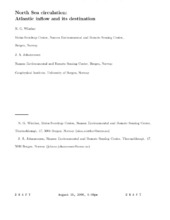| dc.contributor.author | Winther, Nina Gjerde | eng |
| dc.contributor.author | Johannessen, Johnny A. | eng |
| dc.date.accessioned | 2007-02-23T13:34:54Z | |
| dc.date.available | 2007-02-23T13:34:54Z | |
| dc.date.issued | 2006-12-22 | eng |
| dc.Published | Journal of geophysical research 111(C12) | |
| dc.identifier.issn | 0148-0227 | en_US |
| dc.identifier.uri | https://hdl.handle.net/1956/2115 | |
| dc.description.abstract | This study investigates the Atlantic inflow to the North Sea; its variabil- ity, pathways and destination. Results from a numerical model show that the variability of Atlantic inflow is dependent on the inflow location. The inflow between Orkneys and Shetland and in the Shetland shelf area show a strong connection to the strength in westerly winds in winter and spring on a weekly time scale, while the inflow in the Norwegian Trench has a longer response time to the large scale wind pattern. About 50% of the Atlantic water that enters the North Sea is mixed with fresher water before it leaves the North Sea as the Norwegian Coastal Current. This illustrates the important role of estuarine processes within the North Sea and Skagerrak area, and their interaction with the Atlantic water. | en_US |
| dc.format.extent | 2827431 bytes | eng |
| dc.format.mimetype | application/pdf | eng |
| dc.language.iso | eng | eng |
| dc.publisher | American Geophysical Union | en_US |
| dc.title | North Sea circulation: Atlantic inflow and its destination | en_US |
| dc.type | Peer reviewed | |
| dc.type | Journal article | |
| dc.description.version | acceptedVersion | en_US |
| dc.rights.holder | Copyright 2006 by the American Geophysical Union | en_US |
| dc.identifier.doi | https://doi.org/10.1029/2005jc003310 | |
| dc.source.journal | Journal of Geophysical Research | |
| dc.source.40 | 111 | |
| dc.source.14 | C12 | |
| dc.subject.nsi | VDP::Matematikk og Naturvitenskap: 400 | nob |
